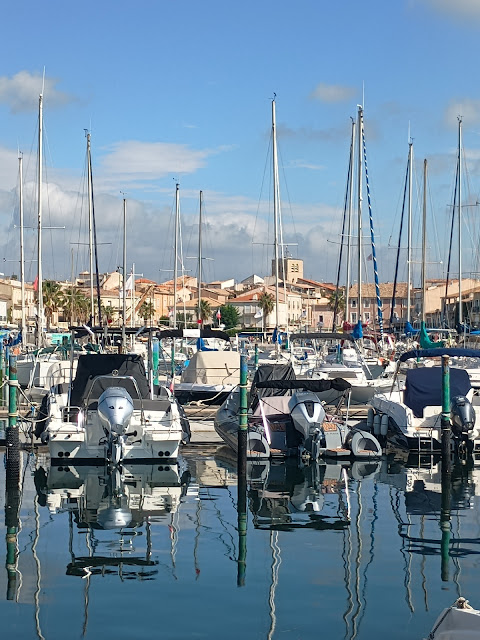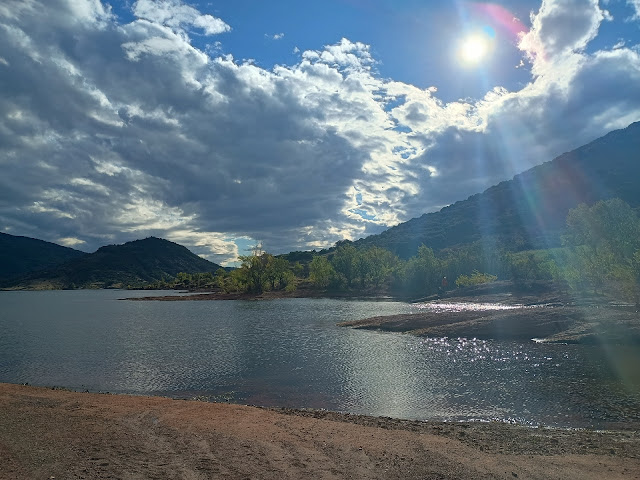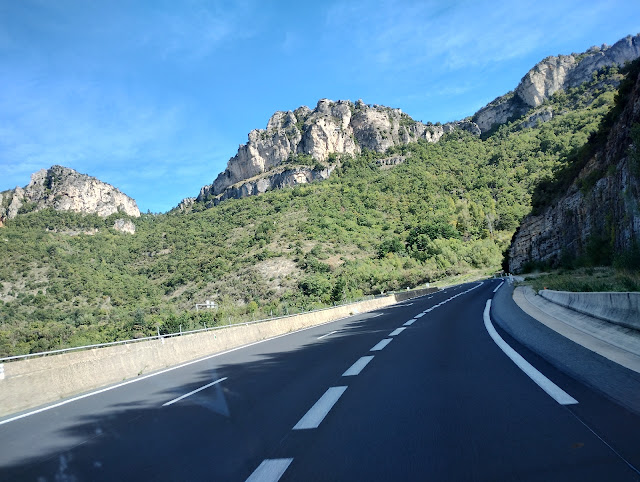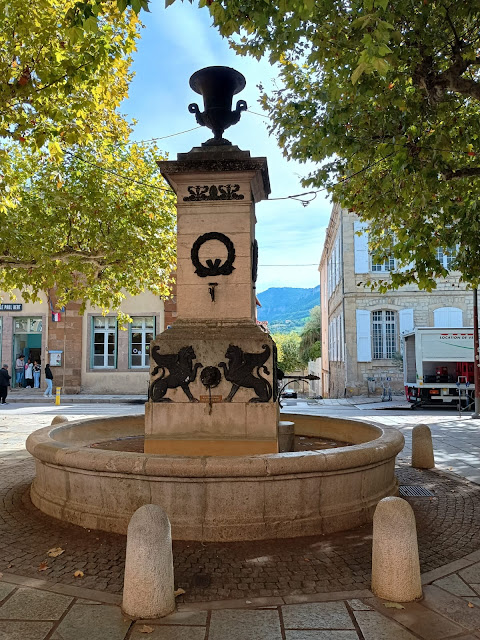Trips actually end when we park the van in front of our house, unload, , then drive it back to the farm on the outskirts of Buxton where it's stored. However, the beginning of the end happens much earlier, the moment when incontrovertibly we are homeward bound. More often than not it coincides with saying goodbye to the Mediterranean and turning northwards.
It is a valedictory moment that demands a symbolic act. Visiting Meze market seemed a good way to bid farewell. Every Thursday and Sunday the the big space in front of the market hall and the nearby square by the Marie are packed with stalls, some selling produce others bric-a-brac and terrible clothes.
We bought some overpriced veg and a loaf that purported to be local. When we googled the name on the paper bag it turned out the bakery had a dozen or more outlets across Languedoc and the southern Auvergne, employed 250 people and was dedicated to supplying bread to many local markest. It raises the question how local is local.
Still, Meze market remains a much loved instutuon even if the people selling veg, meat and cheese aren't really local producteurs and half the non-food items look like they've been 'sourced' at Amazon. We'd hoped to get lunch from the Market Hall bar who usually serve up oysters and prawns from the Etang.
For some reason food was not available. We had a drink anyway, Gill went for a local rosé, I decided on sparkling - water. My post viral taste problem forced me to go teetotal for the first time in 52 years. Over the last couple of months I 've managed a small glass of beer, more recently a spirit sizes shot of sherry. Sadly wine has a vinegary aftertaste, so here I am hitting the Perrier.
That's what we did yesterday. Today time to head north. It always makes me feel sad. This time we attempted to soften the blow by only heading 49km up the A75.
Our original plan was to include a couple of stops at lakeside campsites so I could practice standing up on my paddle board. I can do it, but getting from a crouched position to upright still feels alarming and I need to practice the movement until it becomes normalised.
At best the weather this trip has been unsettled, occasionally alarming. Our stay at Lake Idro was cut short when the van developed a leak and we needed to find a place that could repair it. We shelved our planned visit to Lake Trasimeno because storms were forecast. Cala Montgro was breezy and the swell in the cove too challenging for a SUP novice. It's all been a tad frustrating from my point of view.
So now we are here at Lake Saligou near Clermont l'Herault. It's a manmade lake in an area of spectacular red soil, it looks a little otherworldly.
We rented a house on the opposite shore in 2012, the area is not by the Med but close enough to enjoy a Mediterranean climate, which is a delightful thing - deep blue skies, sunny days, but breezy. From a distance the lake looked idyllic.
Up close it looked like this...
Nobody was out on a paddle board, even the stalwart kite surfers found the conditions challenging, momentarily hydrofoiling across the lake like butterflies in a hurricane before falling in.
By evening the winds dropped a little, 17kph gusting to 26kph. I inflated my board, donned a wetsuit and headed out. Standing-up wasn't an option but it was fun just using the board like a kayak. Then it got squally, SUP's are light and currents and strong winds blow them about. I began to have difficulty controlling the board and became concerned that if I was blown into the middle of the lake I would not have the strength to paddle against the current back to the beach.
I headed to a nearby cove and ran aground. It was a long way to carry the board back to the van but that seemed the safer option. Later, I googled SUP and wind strengths. The site recommended that beginners don't use their boards in winds stronger than 9kph, I had been out in more than twice that. What I needed was flat calm conditions to build my confidence up I decided.
Next day we were due to leave the site before 11pm. When I woke the wind had dropped. I was back out on the water by 9am. However, it was still a bit choppy. Again I had fun using the board kayak style and paddled out into the middle of the lake, still I didn't have the confidence to stand-up, it's a mental block issue, I can do it but my brain says no even if there are the smallest of wavelets. Annoyingly two hours later as we drove out of the site Lake Saligou was like a mirror, a gaggle of standing up paddleboarders were out there. I can't see me getting back on the board until February when we are in Portugal. I had hoped that on this trip that I would have been able to get beyond the novice stage on the board, unsettled weather put paid to that. It's frustrating.
We are still at the stage of taking baby steps north, in denial that we have to be in Calais in just over a week's time. We headed to Millau. It's a place which we have observed over the past two decades transform itself from a dour looking upland bottleneck into a stylish, cultured town with a bit of a provençal vibe.
Two things have contributed to Millau's makeover. The eponymous viaduct removed the traffic jams. Then some time late last century the drab looking concrete faced houses got colour washed in regulation Cote d'Azur ochres, terracottas and soft pinks.
We've seen this process of 'St Tropificaion' elsewhere. I've tried to find out a couple of times when exactly the fishing villages of the Cote d'Azur acquired their signature colouration. It's trickier than you might think, I haven't come across an article that directly explores the question. I would guess it can't have been before the mid-nineteenth, it was only then that developments in the chemical industry resulted in cheap pigments that allowed the mass production of coloured paints. When the pointillist Paul Signac visited St Tropez in 1898 his paintings reveal the waterfront houses were colour washed.
When we first visited the south of France the classic Riviera colour washed look tended to be concentrated in places near the coast. The towns and villages inland looked more dour, mainly dull concrete facades with the odd pastel painted frontage here and there. Then St Tropification spread, firstly in Provence then into parts of Languedoc. It's a nice thing.
We had no grand plans. The campsite we use in Millau is next to the Tarn and only a ten minute walk from the town centre.
We have a favourite café in Place Maréchal Foch, the food is nothing special but we love the location. The square lives up to every day-dream you might have about 'le Midi', cafe tables sunlight dappled, the square itself arcaded with a fountain in the middle.
The town's primary school occupies one corner. The building is old, the front windowless with an ancient grand doorway. It looks a little forbidding for a place of learning for young children. At noon a gaggle of parents gathered outside to collect their kids. From benches dotted about the square a few of Millau's senior citizens observed the mid-day ritual. I sensed the familiar pulse of communal life, the moment exuded a quiet optimism, how small things can be uplifting in a troubled world.
The cafe's menu has evolved from last year when we ordered a well made croque monsieur with a side salad. The 'menu formule' was too much for us at lunchtime. It wasn't possible to go 'off piste' this time so we settled for two small salads off the lunch menu. As small salads go they were very big and somewhat random, a melange of ingredients thrown together without much thought about flavour combinations.
Mine included a French attempt at spanakopita. Feta in filo packages was a bit Greek, but no herbs or garlic to make it flavoursome. Gill's salad was equally bland and the eggs with greyish yolks she left to one side. Nevertheless, it is a lovely spot to have a relaxed lunch.
Judging by the posters and graffiti the town seems quite left leaning and forward looking.
The modern developments are not horrible, just a tad over-styled.
The place's post modern take on public seating was quite sculptural, better to look at than sit on.
And that's it, goodbye to the south. What follows next is a long drive home breaking all our self imposed rules about not making a mad dash for it. Experience has taught me that three days of driving with two stops is the longest I can manage easily before I need a two night stopover somewhere. To fit in a visit to Gill's sister in northeast France we are planning a six day drive home with five consecutive overnight stops. Why am I doing this to myself? I have no idea.





















